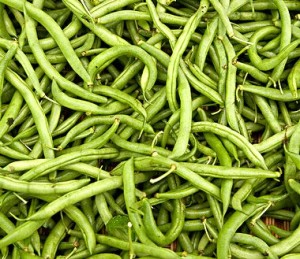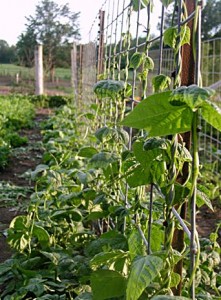 Pole Beans or string beans and often called as Sitaw in the Philippines, is the common garden bean can be both stringless and colors other than green. But it’s the pole bean that everyone recognizes as one of the most frequently prepared vegetables in the country. The crisp young pods, which have a high nutritional value, can be sauteed alone or cooked along with other vegetables. Pole beans are versatile in the kitchen and very prolific producers in the garden.
Pole Beans or string beans and often called as Sitaw in the Philippines, is the common garden bean can be both stringless and colors other than green. But it’s the pole bean that everyone recognizes as one of the most frequently prepared vegetables in the country. The crisp young pods, which have a high nutritional value, can be sauteed alone or cooked along with other vegetables. Pole beans are versatile in the kitchen and very prolific producers in the garden.
Pole beans is one of the many variety of string beans which grow upwards or across a trellis for about 10′ tall and either round or flattened in shape. Most varieties of pole beans are green, but you’ll also find purple, red, yellow and streaked varieties. Pole beans are eaten while still immature. They are picked young and tender, before the seeds inside have fully developed.
Production of Pole Beans or Sitaw
Varieties:
- CSL-19- early maturing variety, which flowers 37 to 43 days after planting. Pods are light green, crisp, smooth textured, and non-fibrous with good eating quality. CSL-19 is moderately resistant to black bean aphids and bean fly. Other light-green-podded varieties are CSL-14, CSL-15, CSL-16, PS3, and PS 1.
- 83-0002 ? is a variety with dark green leaves, which flowers 39-48 days after planting, It is moderately resistant to bean fly and pod borer and has a high level of resistance to fusarium wilt. Pods are dark green with purple tips, crisp and non-fibrous, and with good eating quality. Seed coat is very thick. Other fark-green-podded varieties are Sandigan, CSD-4, 87-005, Acc 288, CSD-36 and 89-020.
Climate and Soil Requirements
Pole sitaw is well adapted to the lowland tropics with a temperature range of 20-35C. It grows best under full sunlight although it can also tolerate partial shading.
Adequate supply of water and a rich, friable, fertile soil promotes healthy growth and good quality pods.
Planting
Pre-germinate or directly sow seeds in pots or drill 2.5 to 3.5 cm deep in the plots with a distance of 30 cm. Construct trellis/stakes, 200-250 m long to support the vines after the seedlings have fully developed. Boxes, plastic twines, abaca twines or wire will also help support the climbing habit of the crop.
Apply organic waste to enhance crop vigor and yield. Mulch the crop with grass clippings and kitchen waste.
To minimize pest and damage, plant marigold and holy basil (solasi) in borders to repel insects. Spread grated coconut waste over the plant to invite ants, which feed on worms. Spray hot pepper extract with soap against aphids and podborers.

Harvesting
Pick young pods six to seven weeks after planting or when seeds become visible on the outline of the pod. Fresh pods left in the field becomes tough and dissolved. Seeds become swollen, which reduces yielding capacity. Harvest every 2-3 days.
For marketing, 20-40 pods may be bundled. Store in a cool (8C), dry place up to four weeks.
Source: PCARRD Pole Sitaw Production Guide; Photo: organictobe.org and gardenguides.com